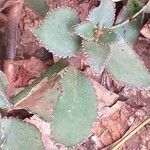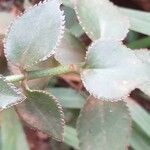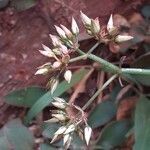Leaves condensed towards the lower part of stem, there petiolate and spreading-decurved, the median and the upper ones usually rather scattered, distinctly smaller than the lower, sub-bract-like, shortly petiolate to subsessile, ascending; lamina of the lower leaves 3·5-16(21) x 3-10(12·5) cm., subcircular or broadly obovate, less than twice as long as broad, rounded or obtusely acuminate at the top, crenate or doubly crenate at margin, rounded or cuneate at the base, the others obovate-spathulate to linear-cuneate, nearly or quite entire, flat in all leaves and rather fleshy, not very thin and somewhat rigid, dark brown or dark green when dry; petiole 0·5-5 cm. long, channelled, rather broad.
Corolla 13·5-17 mm. long; tube 8·5-14 mm. long, dilated at base, yellow-orange turning white-hyaline below and pale-pink upwards at fruiting; corolla-lobes 4·5-7(8·5) x 2-4·2 mm., ovate or elliptic, attenuate or abruptly contracted at the apex, long apiculate, usually orange-red or brilliant scarlet-orange to brick-red, rarely yellow.
Stem erect, usually simple, sometimes forked into two ± long floriferous axes, 0·5-1·8 cm. in diameter at the base, terete, leafless at fruiting time; lower internodes (from below upwards) 0·3-7 cm. long, the median ones 6-15 cm. long, the two terminal ones usually very elongate, (12)18-29 cm. long.
Flowers in ± dense cymes grouped either in a single ± dense small terminal corymb or in a larger looser one (up to 20 cm. in diameter) or sometimes in several corymbs disposed in thyrsoid or panicle-like inflorescences, very densely rusty-pubescent-glandular; pedicels 1-3·5(5) mm. long.
A succulent perennial, pubescent-glandular throughout, 19-150 cm. high (incl. the inflorescence); hairs of the indumentum up to 1(1·5) mm. long, spreading, thin, capitate-glandular, ± dense, tawny to dark-brown or rusty-red on drying.
This description applies to var. lateritia, var. prostrata Raadts, with prostrate stem and glabrous leaves and stern, and var. pseudolateritia Raadts, with a slightly longer corolla-tube, were described from Kenya and Tanzania.
Calyx (4)5-7(8) mm. long; tube (0·3)0·5-1(2) mm. long; sepals (1)1·5-2·5(3) mm. broad at the base, ovate-oblong to oblong-lanceolate, rarely ovate, ± attenuate, acute or subacute, green, lineolate with red.
Filaments ± 2·5 mm. long, insertedd above the middle of corolla-tube; anthers ± 0·75 mm. long, oblong, included.
Seeds c. 1 x 0·33 mm., oblong-linear, longitudinally slightly ribbed, curved at the top.
Follicles (4)-6-8(9) mm. long, attenuate into the 0·75-2 mm. long styles.
Scales 1·75-4 mm. long, linear.




